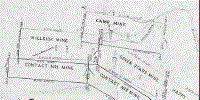
|
(Written by Colonel J.C. Fremont in 1847 (and updated in 1852) about his explorations and observations of California during the Gold Rush.)
The fragments of rock and ore are removed on the backs of Indians, in raw- hide sacks. The ore is then hauled in an ox wagon, from the mouth of the mine down to a valley well supplied with wood and water, in which the furnaces are situated. The furnaces are of the simplest construction-- exactly like a common bake-oven, in the crown of which is inserted a whaler's frying-kettle; another inverted kettle forms the lid. From a hole in the lid a small brick channel leads to an apartment or chamber, in the bottom of which is inserted a small iron kettle. The chamber has a chimney. In the morning of each day the kettles are filled with the mineral (broken in small pieces) mixed with lime; fire is then applied and kept up all day. The mercury is volatilized, passes into the chamber, is condensed on the sides and bottom of the chamber, and flows into the pot prepared for it. No water is used to condense the mercury. |